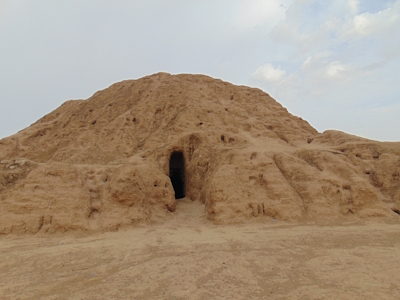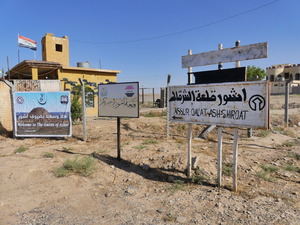Ashur

Ashur (Qal'at Sherqat) comprises the remains of the first capital of the Assyrian Empire.
The city was the centre for worship of the god Ashur and the goddess Ishtar/Inanna. Ashur contained many important religious buildings and a handful of palaces. They show the evolution of the building practice from the Sumerian to the Parthian periods.
Community Perspective: Located near Mosul, it has been off-limits for decades. Thomas managed to visit in 2021 – the site hasn’t seen as much war damage as other Iraqi sites, but not much has been excavated. Clyde went in 2024 and highlighted the site's history.


Map of Ashur
Community Reviews
Clyde

I visited this WHS in September 2024 as a long day trip together with Hatra. An early start to the day and a reputable fixer/tour agency with good contacts is essential to allow for the several military checkpoints and to make sure everything goes smoothly. Even though eventually everything went very smoothly and I made it in time for both WHS, I wouldn't have made it without an early start.
Ashur was the capital of the Old Assyrian city-state (2025–1364 BC), the Middle Assyrian Empire (1363–912 BC), and for a time, of the Neo-Assyrian Empire (911–609 BC). The remains of the city lie on the western bank of the Tigris River, north of the confluence with its tributary, the Little Zab. Unlike Babylon, almost no reconstructions remain or were made. From Ashur onwards, the effects of the conflicts and the tensions and destruction they brought with them are clearly visible. Upon arrival, you'll immediately notice the several bullet holes in the makeshift UNESCO WHS signs.
The oldest remains of the city were discovered in the foundations of the Ishtar temple, as well as at the ruins of the Old Palace. During the Akkadian Empire (around 2334-2154 BC), Ashur was a provincial capital led by a vassal of the Akkadian kings. During the 3rd Dynasty of Ur (around 2112-2004 BC), Ashur continued as a governorate subject to the Sumerians. By the time the Neo-Sumerian Ur dynasty collapsed at the hands of the Elamites around the end of the 21st or 20th century BC, following increasing raids by Gutians and Amorites. The native Akkadian-speaking Assyrian kings were now free while Sumer fell under the yoke of the Amorites. As the region enjoyed relative peace and stability, trade between Mesopotamia and Anatolia increased, and the city of Ashur greatly benefited from its strategic location.
The Amorite ruler of the Kingdom of Upper Mesopotamia conquered Ashur and made it his religious capital. In this era, the Great Royal Palace was built, and the temple of Ashur was expanded and enlarged with a ziggurat. However, this empire met its end when Hammurabi, the Amorite king of Babylon, conquered and incorporated the city into the 1st Babylonian dynasty empire, while the next three Assyrian kings were viewed as vassals of Babylon. Temples to the moon god Sin (Nanna) and the sun god Shamash were built and dedicated through the 15th century BC. The Anu-Adad temple was established later and the city was fortified with 300 acres of defensive walls.
In the Neo-Assyrian Empire (912–605 BC), the royal residence was transferred to other Assyrian cities. Ashur-nasir-pal II (884–859 BC) moved the capital from Ashur to Kalhu (Calah/Nimrud) following a series of successful campaigns and produced some of the greatest artworks in the form of colossal Lamassu statues and low-relief depictions of the royal court as well as battles (all scattered in different museums worldwide; the ones at the National Museum of Baghdad should not be missed and IMHO are worth a trip to Iraq alone if you love ancient history!). The city of Ashur remained the religious center of the empire and continued to be revered as the holy crown of the empire, due to its temple of the national god Ashur. The city was sacked and largely destroyed during the decisive battle of Assur, a major confrontation between the Assyrian and Median armies. This left mostly a series of foundations, mud brick walls, wells, clay tiles, and ziggurats in ruins which can still be seen at the site and have been partially excavated. Loads of artefacts have been unearthed from the different eras explained above, but also from later empires such as the Persian Achaemenid and the Parthian Empires, although the Sasanian sacked and largely destroyed what was left of the city of Ashur.
Unlike the great damage inflicted by ISIS at Nimrud, Hatra, Khorsabad, Nineveh and Mosul, Ashur didn't suffer as much, probably because there weren't any "pagan" statues left in situ. As a silver lining, the 2003 invasion of Iraq also led to putting on hold and hopefully forgetting a large-scale dam project that would have submerged the ancient archaeological site of Ashur. Since 2023 a German archaeological team has resumed work at Ashur and is focusing on excavations of the New City.
Thomas Buechler

Ashur (Assur) was the first Assyrian capital and remained so for a long period (1400 to 608 BC). Located on the western banks of the Tigris River, just a bit north of the confluence with the Lesser Zab river, it became an important trading and religious centre with a large ziggurat. The city lies about 140km south of Mosul, and we visited the place on the first day of November 2021, coming from Baghdad on our way to Mosul. Our guide Hayder did his homework. The chief of security at this important archaeological site gave us an entry permit on the spot, and we were even driven around the premises in his private car. Here excavations have been done predominantly by German archaeologists, starting as early as 1903, about 4 years after Babylon. Not surprisingly that many of Ashur's artefacts and statues are kept safe far away, in Berlin's Pergamon Museum, some are in the Archaeological Museum in Istanbul. Good in that case, since the nearby Mosul Museum has suffered severe damage to its collections. Ashur was not destroyed by the ISIS extremists on the same magnitude as Nimrud, Hatra or Mosul/Nineveh, simply because only a few palaces and temples (10 out of 34) are fully excavated. But another threat comes from the Makhul Dam project, an ambitious plan of the Iraqi government, creating a 20 mile-long lake, most likely partially flooding the ancient city of Ashur. After a long pause due to the Gulf war, and political turmoil, construction of the dam has just started this year, according to Iraqi press releases.
Community Rating
Site Info
- Full Name
- Ashur (Qal'at Sherqat)
- Unesco ID
- 1130
- Country
- Iraq
- Inscribed
-
2003 - In Danger
- Type
- Cultural
- Criteria
-
3 4
- Categories
- Archaeological site - Near Eastern
- Link
- By ID
Site History
2003 In Danger
Dam proposal; state of war in the country
2003 Inscribed
Site Links
Unesco Website
Official Website
In the News
Connections
The site has 30 connections
Art and Architecture
Constructions
Damaged
Geography
History
Human Activity
Individual People
Religion and Belief
Timeline
Trivia
Visiting conditions
WHS Names
WHS on Other Lists
World Heritage Process
Visitors
21 Community Members have visited.
The Plaque
 (photo by Clyde)
(photo by Clyde)